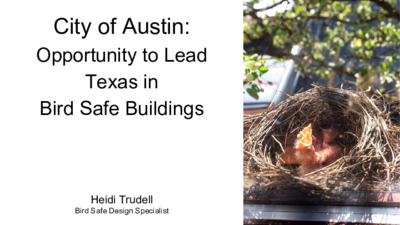02. Bird-Safe Buildings Presentation — original pdf
Backup

City of Austin: Opportunity to Lead Texas in Bird Safe Buildings Heidi Trudell Bird Safe Design Specialist Roadmap: Geography + conservation Design in action Austin is in the heart of North America’s Central Flyway, which is the spring and fall migration corridor for hundreds of species of birds. Texas is home to three of the top 10 deadliest cities for birds: Houston, Dallas, and San Antonio, making it critical to proactively preserve biodiversity. Local buildings have global consequences What’s good for birds is good for people. © M.W. York 2006 With a great state comes great responsibility: Bird watchers spend $1.8 billion/yr in Texas 427 species of birds have been recorded in Travis Co. (more than 14 states) Austin has committed to maintaining a Bird City designation, achieving the status in February 2023. Birds are unable to see glass. Window collisions kill 621 million to 2 billion birds per year in the US. Bird safe building standards align with Austin’s values of being a biodiverse, ecologically resilient community. Every building that is made bird safe - as new construction or as a retrofit - will save dozens to hundreds of birds per building, per year. To date, no city in Texas has enacted a bird safe standard. NYC, Mountain View, Toronto, Chicago, San Francisco, Portland, Washington DC + 22 more Birds and buildings can coexist. Cost % of project totals: Bird-safe glass can range from 0.00021% to 0.38% of total project cost for a new building. When incorporated from the schematic design phase or pre-design phase, bird safe features are not a financial burden, not an energy burden, not a visual burden. After design development, costs, delays, and logistical challenges increase. Suggested Reading: Bird-Safe Windows A Winner For Builders and Birds A Report of the Ornithology Center at Muhlenberg College © M.W. York 2006 Comprehensive codes include: ● Ground level to above tree canopy (the most critical zone) ● Include all hazardous features (glass walkways, railing, corners, etc.) ● New and retrofit construction ● All habitats, no restrictions ● Defined, acceptable measures of collision prevention Voluntary codes may include incentives for compliance. Image: LEED Innovation Credit: Bird Collision Deterrence Incomplete codes apply only to buildings: ● Over x ft high ● Over x square feet ● Within x feet of x habitat ● On sides more than x% glass ● Only [listed] products can be used, or x% reflectivity range ● Seasonally (lighting) Image: San Francisco Bird- Safe Building Standard “low reflectivity glass is safe” “glass as clear as possible so birds will see there’s nothing inside for them to go to” “minimal glass on north side because of migration” “low reflectivity glass is safe” “glass as clear as possible so birds will see there’s nothing inside for them to go to” “minimal glass on north side because of migration” The Natatorium is brick. Where’s the problem? The Natatorium is brick. Where’s the problem? “The more masonry a building has, the safer it is.” “The more masonry a building has, the safer it is.” “Funnel” features Birds see isolated portals Landscaping is a risk factor but not a prevention method Comprehensive resources exist, product options are diversifying (abrasive/acid/laser etch, frit, UV, etc.) What is hindering companies from investing in… valuable conservation projects? …lack of information about the environmental and economic impacts of their investment. Despite their impactful environmental, economic, and social returns… conservation projects are often boxed out of corporate sustainability portfolios. - Texan By Nature What’s good for birds is good for people. Keep Austin birdy. © M.W. York 2006 Questions? Heidi Trudell - justsavebirds@gmail.com by Guardian Glass. Additional reference: Design Commission report April 22, 2024 Design Commission The Travis Audubon Society requested this report on bird safe buildings for presentation to the City of Austin and general dissemination within the Central Texas community. It was submitted to the South Central Waterfront Advisory Board on March 18, 2024, and was prepared by Heidi Trudell, a bird collision prevention researcher and consultant, who in March 2024 was hired as a technical advisor